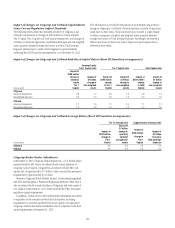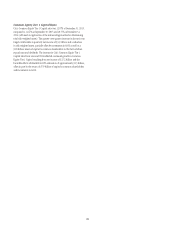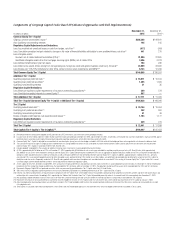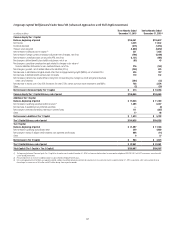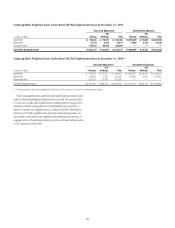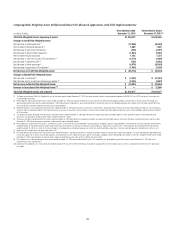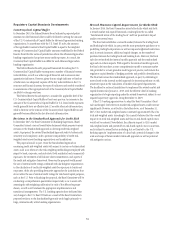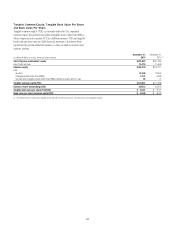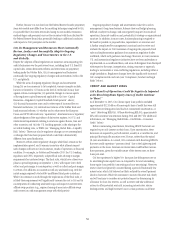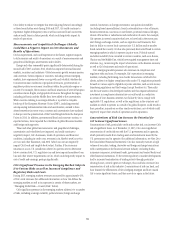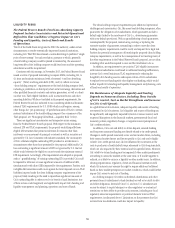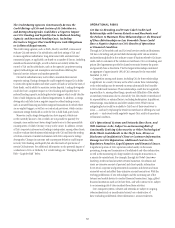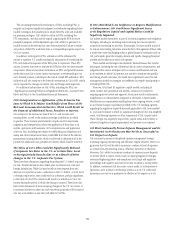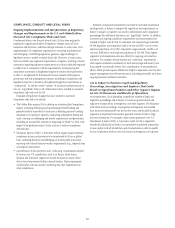Citibank 2015 Annual Report Download - page 69
Download and view the complete annual report
Please find page 69 of the 2015 Citibank annual report below. You can navigate through the pages in the report by either clicking on the pages listed below, or by using the keyword search tool below to find specific information within the annual report.51
Regulatory Capital Standards Developments
Countercyclical Capital Buffer
In December 2015, the Federal Reserve Board released a proposed policy
statement on the framework that would be followed in setting the amount
of the U.S. Countercyclical Capital Buffer for Advanced Approaches banking
organizations. In accordance with the U.S. Basel III rules, the amount
of the applicable Countercyclical Capital Buffer is equal to the weighted
average of Countercyclical Capital Buffer amounts established by the Federal
Reserve Board for the national jurisdictions where the Advanced Approaches
banking organization has private sector credit exposures. As a result, the
Countercyclical Capital Buffer may differ for each Advanced Approaches
banking organization.
The Federal Reserve Board’s proposed framework for setting the U.S.
Countercyclical Capital Buffer encompasses a number of financial-system
vulnerabilities, as well as a wide range of financial and macroeconomic
quantitative indicators. However, given that no single indicator or fixed set
of indicators can adequately capture all the key vulnerabilities in the U.S.
economy and financial system, the types of indicators and models considered
in assessments of the appropriate level of the Countercyclical Capital Buffer
are likely to change over time.
The Federal Reserve Board expects to consider the applicable level of the
U.S. Countercyclical Capital Buffer at least once per year. An increase in the
amount of the Countercyclical Capital Buffer for U.S.-based credit exposures
would generally have an effective date 12 months after such determination,
while a decrease in the amount of the Countercyclical Capital Buffer would
generally become effective the day after such determination.
Revisions to the Standardized Approach for Credit Risk
In December 2015, the Basel Committee on Banking Supervision (Basel
Committee) issued a second consultative document which proposes various
revisions to the Standardized Approach in deriving credit risk-weighted
assets. As proposed, the revised Standardized Approach seeks to balance risk
sensitivity and complexity, and to promote comparability of credit risk-
weighted assets across banking organizations and jurisdictions.
The proposal would, in part, revise the Standardized Approach in
measuring credit risk-weighted assets with respect to certain on-balance sheet
assets, such as in relation to the risk-weighting methodologies employed with
respect to bank, corporate, and real estate (both residential and commercial)
exposures; the treatment of off-balance sheet commitments; and aspects of
the credit risk mitigation framework. Moreover, the proposal would permit
the use of external credit ratings combined with due diligence requirements
in the calculation of credit risk-weighted assets for exposures to banks and
corporates, while also providing alternative approaches for jurisdictions that
do not allow the use of external credit ratings for risk-based capital purposes,
such as the U.S. Prior to finalizing the proposal, the Basel Committee will be
conducting a comprehensive quantitative impact study so as to assist with
assessing the risk-weighting calibration for each of the affected exposure
classes, as well as will evaluate the appropriate implementation and
transitional arrangements. The U.S. banking agencies have indicated that
any changes to the U.S. Basel III rules as a result of the Basel Committee’s
proposed revisions to the Standardized Approach would apply primarily to
large, internationally active banking organizations.
Revised Minimum Capital Requirements for Market Risk
In January 2016, the Basel Committee issued a final rule which sets forth
a revised market risk capital framework, resulting from the so-called
“fundamental review of the trading book” and four quantitative impact
studies over several years.
The final rule establishes a revised boundary between the trading book
and banking book which, in part, provides more prescriptive guidance as to
qualifying trading book positions as well as imposes heightened restrictions
and, in certain instances, additional capital charges, on the transfer of
positions between the trading book and banking book. Moreover, the final
rule also revises both the internal models approach and the standardized
approach in certain respects. With regard to the internal models approach,
the final rule introduces a more comprehensive model to measure market
risk, provides for a more granular model approval process, and reduces the
regulatory capital benefits of hedging activities and portfolio diversification.
The final rule revises the standardized approach, in part, by calibrating it
more closely to the internal models approach by increasing reliance on risk
sensitivity inputs in the calculation of market risk capital requirements.
The deadline for national jurisdictions to implement the revised market risk
capital framework is January 1, 2019, with the effective date for banking
organizations to begin reporting under the revised framework, subject to any
required supervisory approvals, being December 31, 2019.
If the U.S. banking agencies were to adopt the Basel Committee’s final
rule unchanged, Citi believes its market risk-weighted assets could increase
significantly. However, as set forth in the tables above, as of December 31,
2015, Citi’s market risk-weighted assets constituted approximately 6% of its
total risk-weighted assets. Accordingly, Citi currently believes that the overall
impact to its total risk-weighted assets and thus its risk-based capital ratios
would not be material. Nevertheless, the ultimate impact to Citi’s market
risk-weighted assets and potentially its risk-based capital ratios is uncertain
and is subject to several factors including, but not limited to, the U.S.
banking agencies’ implementation of a final rule, potential changes in the
scale and scope of future market risk model approvals as well as potential
risk mitigation actions.




